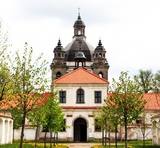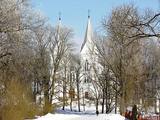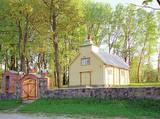| Nr | Name | Beschreibung |
|---|---|---|
|
Die erste Kirche war hier schon am Anfang des 18. Jhs. Danach wurde die zweite und die dritte – die heutige – Kirche (1847 – 1848) gebaut. Das Gotteshaus hat sowohl im Ersten Weltkrieg, als auch während der Sowjetzeit gelitten, als sich hier von 1969 bis 1993 eine Werkabteilung für Watteherstellung befand. Heute bekommt das Gebäude langsam seine Gestalt zurück. In den 1990er Jahren war es in sehr schlechtem Zustand. Es ist noch zu erwähnen, dass von 1826 bis 1856 in diesem Gotteshaus als Küster und Orgelspieler der lettische Dichter und Übersetzer Ansis Līventāls (1803 – 1878) gearbeitet hat. Neben der Kirche befindet sich seine Grabstätte mit einem Denkmal, sowie der Friedhof der im Ersten Weltkrieg gefallenen russischen und deutschen Soldaten und das Grabdenkmal des Pfarrers und Schriftstellers Jacob Florentin Lundberg (1782 – 1857). |
||
|
Ein hervorragendes Sakralensemble im Barockstil (17 – 18 Jh.), eine Kirche und ein tätiger Nonnenkloster. |
||
|
Holy Jesus Heart Roman Catholic Church of Bikova
(Gaigalava). Enjoy the Gothic forms and architectural design of the church. The church and the altar are
decorated with the icons of Zebedee sons – James and John (the apostles of Jesus) and other saints.
|
||
|
Der höchste Punkt im Südteil von Daugavpils – in der Umgebung der 18. Novembra Straße, wo auf einem relativ kleinen Territorium, im Umkreise von ~ 0,3 km sich die Kirchen von vier Konfessionen befinden: das Bethaus für Altgläubige in Daugavpils (1908 – 1928), die St. Boris und Gleb russisch-orthodoxe Kathedrale (1905), die römisch-katholische Kirche der Heiligsten Gottesmutter (1905) und die evangelisch-lutherische Kirche Martin Luthers (1893). |
||
|
St. Michael the Archangel Parish Church of Zosna. The church
was built in 1800 by the donations of local people; it is devoted to Saint Michael. The church is built on the
stone foundation and panelled with boards. It has a small square tower that was restored in 1994.
|
||



